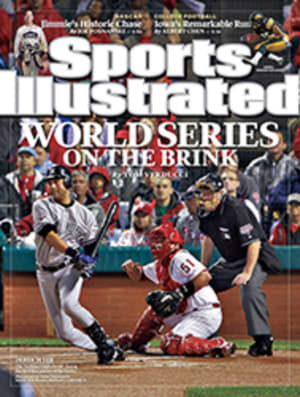
Look Out Below
It's a Monday night in mid-October, and bobsled season has just begun, so where else would the world four-man champions be but in Lake Placid, N.Y., swapping sledding stories at Lisa G's bar? It is wings night, after all. Steve Holcomb, pilot for Team Night Train (USA 1 was a little drab for this blithe bunch), is trying to explain the art and science of negotiating a perfect line down the lightning-quick Lake Placid course. It was there, last March, that he drove his quartet to the first world championship for a U.S. team in 50 years and raised hopes that at the Vancouver Games next February, the U.S. men can win their first Olympic bobsledding gold medal since 1948.
Physics dictates that there is an ideal path for an object weighing nearly 1,400 pounds—human cargo included—and traveling 80 mph down a mile-long, curve-riddled, ice-coated chute. To find that line, says the 29-year-old Holcomb, you reverse engineer the course. If you need to leave curve 20 at a certain height up the track wall in order to maintain top speed, then you have to enter the curve at a height dictated by your exit from the previous turn. In order to do that, you have to know the straightest line from the exit of curve 18 to the entrance of 19, and so on up the hill. Holcomb gives a thoughtful and detailed tutorial. Never mind that two Coors Light bottles are standing in for curve 20, and a Labatt Blue and a candleholder are obliging as curve 19.
Perfection, of course, is unattainable. Nobody gets the sled runners at the exact right millimeter on every turn. That's where the art comes in. The sled is an extension of the driver's body, Holcomb says, and he must feel the pressure in his hands, his arms and his legs and know instantly when he's too high or too low on a curve. A few inches off can quickly become a few feet as the curves pile up and magnify every mistake. Next thing you know, you're careering off the walls—or riding upside down.
Before going on, Holcomb grasps a pair of imaginary D-rings, the handles used to steer the sled, and closes his eyes. He's feeling the curves in his mind as he zooms through the Coors Lights. Driving by feel is something he has grown accustomed to, and not entirely by choice. Two years ago, before he became a world champion, Holcomb almost quit the sport because he had nearly gone blind. His vision had deteriorated to 20/500 from a degenerative eye condition called keratoconus in which the corneas bulge outward. Much of what he does was learned by the Skywalker method.
Recall Star Wars: Obi-Wan trains the young Luke Skywalker to trust what he feels by making him wear an opaque visor while fending off laser blasts. "I can't even see; how am I supposed to fight?" Luke asks.
"Your eyes can deceive you," Obi-Wan replies.
That is especially true in bobsledding, a sport in which waiting for visual cues can hamper a driver's reaction time. But having learned to drive by feel as no driver before him, America's sledi knight will have an advantage on the 2010 Olympic track, the world's fastest, with sleds reaching speeds of 95 mph.
Last year doctors implanted lenses made of a special polymer behind Holcomb's irises. He emerged able to appreciate some simple pleasures he'd never experienced before. "The way leaves flicker in the wind," he says, "that's pretty cool. Before, I just saw green." But his improved condition is a negative in one way. "I actually have to try to ignore what I see now," says Holcomb, who, in a move that would make Obi-Wan proud, has stopped cleaning his helmet visor.
The boiler that gets the Night Train rolling is composed of three guys you would love to meet if your car got stuck in the snow: all former Division I athletes, two football players and a decathlete. But as explosive as that trio is at pushing the sled, the foursome often does not clock the fastest start.
In the team's first of four runs at the 2009 world championships, the Night Train was .04 of a second behind the juggernaut German team piloted by André Lange over the 50-meter start runway, 5.05 to 5.01. And yet the U.S. sled was ahead after only four of 20 curves and finished more than a third of a second faster. In each run at the worlds the Night Train was behind Germany after the start but quickly took the lead. Over four runs the team won by nearly a full second, handing a rare drubbing to the Germans, who have won eight world four-man titles since 2000.
Rather than spending as much time as other teams on the runway pushing the sled, the three athletes behind Holcomb get on board earlier, quicker and more efficiently. Team Night Train loads 880 pounds of spandex-clad men into the sled in just four sprinting steps. Here's how it works.
Holcomb's spike-clad feet leave the ice at around the 25-meter mark, and two steps later Justin Olsen vaults on board. Olsen, 22, is a push prodigy. A 6'2", 225-pound hybrid of strength and speed, he played tight end at Air Force for a season before deciding the Academy was not for him. He was working at a restaurant in his native San Antonio in 2007 when his mother heard an ad for local push tryouts. One year later Holcomb picked him for his squad. "It usually takes three years for an athlete to get to this level," says U.S. Bobsled head coach Brian Shimer, a five-time Olympian. "In 25 years I've seen Willie Gault, Edwin Moses and Herschel Walker do this sport, and Justin has picked it up quicker than anyone I've seen."
Two steps after Olsen boards, Steve Mesler, 31, the team's fastest member, hops on. The three spot is the trickiest, requiring an athlete with the strength to push the sled but the body control to make a surgical entry into it. He must refrain from tugging on the sled, which would decelerate it, and make sure not to land too heavily, lest he cause the sled to bounce. His ability to walk that line is why the 6'2", 212-pound Mesler, an All-SEC decathlete at Florida, gets this hot seat.
As Mesler jumps in, so does 29-year-old Curt Tomasevicz, the brakeman. He hails from Shelby, Neb. (pop. 600) and was a reserve linebacker at Nebraska. The Cornhuskers have a renowned strength-training program, yet the 6'1", 225-pound Tomasevicz squats 80 pounds more now (530) than he did in his football days. Watch him lift the back of a 460-pound sled during routine maintenance and behold a human jack. "My strength," he says with a bashful Midwestern smile, "is my strength."
When you spend six months a year sharing hotel rooms, praying to find American food chains off the autobahn and doing your best sardine impression in a sled, it helps if you enjoy each other's company. "When you like each other, you win for each other," says Holcomb.
Earlier this year, while testing the 2010 Olympic course, the team executed a gag heard round the bobsled world. On a brown paper bag they wrote CURVE 50/50, and Holcomb stealthily taped the sign to the wall of curve 13, marking the spot where half of the teams had rolled over.
Such a prank "never would have happened before," says Mesler, who took a disappointing seventh at the 2006 Turin Games in a sled with driver Todd Hays. "With [the '06] team you had to have your game face on at all times."
Besides a relaxed attitude, new technology is helping too, and that comes thanks largely to NASCAR driver Geoff Bodine. Watching the 1992 Albertville Games, Bodine was dismayed at the poor quality of America's sleds—the team would buy used ones from European competitors—so he started the nonprofit Bo-Dyn Bobsled Project. With Bodine's friend and chassis builder Bob Cuneo as head engineer, the project became "the savior of U.S. bobsled," Shimer says, making sleds that are 100% American. In the Night Train, the U.S. has a vehicle on par with sleds made by the Germans and the Swiss.
Now the team wants to generate fan interest on par with those countries'. Up until now Cool Runnings, the 1993 film about the '88 Jamaican bobsled team, has been just about the lone touchstone of the sport for most Americans. But Mesler points out that bobsledding has a lot in common with other sports that U.S. fans enjoy. "We're going 95 mph with no shocks or struts," he says. "You've got big football players and the risk of injury. Speed, violence, big guys in too-tight clothes ... what more do Americans need?" Mesler knows the answer, and it provides motivation as Team Night Train looks ahead to Vancouver. "Americans like winning," he says.
Now on SI.com
Check out the SI Vault for a story on Willie Gault's quest for bobsled gold in 1992 at SI.com/bonus
In 2007 Holcomb almost quit the sport because he had gone nearly blind.
PHOTO
Photograph by MATTHEW STOCKMAN/GETTY IMAGES
ROSEBUDDIES (Clockwise from left) Mesler, Tomasevicz, Olsen and Holcomb gave the U.S. its first world championship since 1959 at Lake Placid in March (opposite).
PHOTO
NANCIE BATTAGLIA
[See caption above]
PHOTO
NANCIE BATTAGLIA

